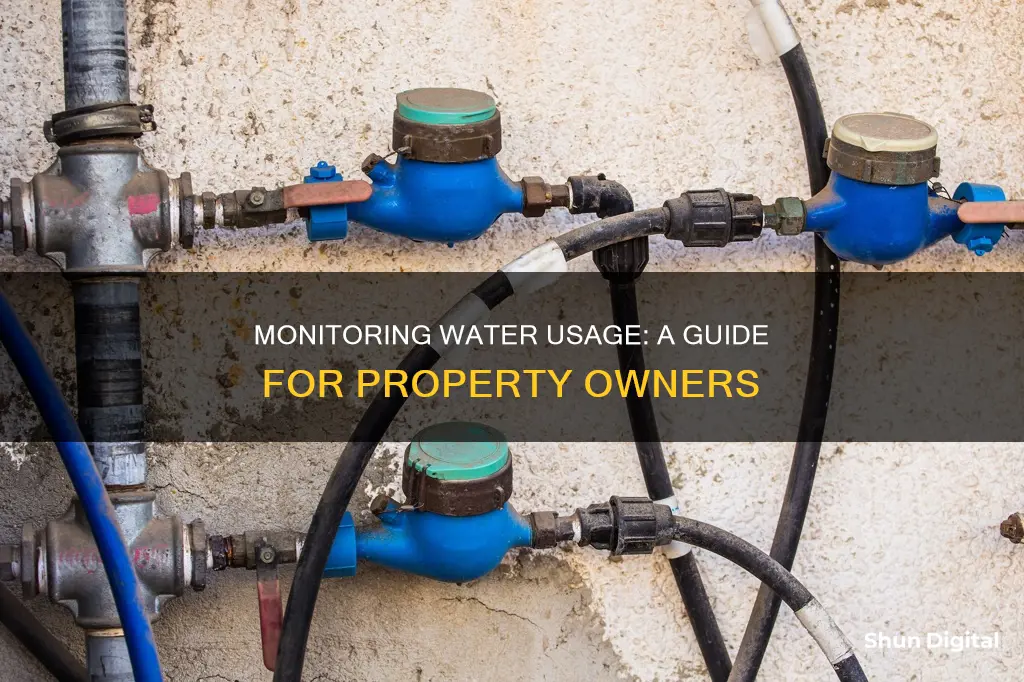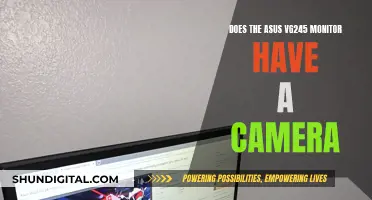
Monitoring water usage on a property is essential for efficient water management and conservation. Traditionally, water monitoring has been a manual process, relying on mechanical water meters installed by utility companies. However, this method has drawbacks, including inaccuracy due to human error and lack of real-time data. Nowadays, smart water monitoring solutions, such as smart water meters and water flow meters with AI-enhanced monitoring, offer more accurate and timely insights into water usage, helping identify leaks and inefficiencies. These modern tools empower property owners and tenants to make informed decisions, conserve water, and manage costs effectively.
| Characteristics | Values |
|---|---|
| Traditional Methods | Reading the mechanical water meter installed by the water utility company |
| Drawbacks of Traditional Methods | Inaccuracy associated with manual readings, time-consuming, lack of real-time data |
| Modern Solutions | Smart water meters, Water flow meters, Smart infrastructure |
| Smart Water Meters | Transmit detailed water usage data directly to the utility provider and the consumer |
| Water Flow Meters | Send collected data to an AI-powered dashboard for in-depth analysis |
| Smart Infrastructure | Technologically advanced pipes and valves that automate and optimize water flow according to real-time demand |
| Commercial Solutions | StreamLabs, Flume, Flo by Moen, Phyn, Flows |
What You'll Learn

Using a smart home water monitor
Smart home water monitors are an effective way to monitor water usage on your property. These devices are designed to help you detect leaks, prevent water damage, and control your water usage. One such device is the Flume 2 Smart Home Water Monitor, which is compatible with 95% of homes and can be installed in under 10 minutes with no plumbing required.
Features of Smart Home Water Monitors
Smart home water monitors like Flume offer a range of features to help you manage your water usage:
- Real-time data and alerts: These devices provide real-time data on your water usage, allowing you to detect leaks and abnormal water usage. You can receive alerts via a smartphone app, text, or email.
- Detailed water usage insights: You can access detailed water usage data, including indoor and outdoor consumption, and break down your water use by individual appliances and fixtures. This helps you identify water-hogging appliances and reduce your use.
- Custom budgets: You can set daily, weekly, or monthly water usage budgets and receive alerts when consumption exceeds the budget. This helps you stay within your desired usage limits and save money on your water bill.
- Integration with smart home systems: Some smart home water monitors, like Flume, can integrate with smart home systems such as Alexa, Google Home, or Orbit Integration. This allows you to control and monitor your water usage using voice commands or through a central system.
- Easy installation: Smart home water monitors are typically easy to install and do not require any plumbing or wiring. The installation process usually involves downloading an app, connecting to Wi-Fi, and fastening a sensor to your water meter.
Benefits of Smart Home Water Monitors
- Water leak detection: These devices can detect water leaks early on, helping you prevent water damage and reducing the cost of repairs.
- Improved water conservation: By providing detailed water usage data and alerts, smart home water monitors encourage more conscious water use and help you identify areas where you can conserve water.
- Cost savings: By detecting leaks and providing insights into water-hogging appliances, smart home water monitors can help you reduce your water bill. Additionally, some water utility providers offer rebates or discounts for using smart water monitoring devices.
- Convenience: Smart home water monitors eliminate the need for manual water meter readings, saving you time and effort. They also provide remote access to your water usage data, allowing you to monitor your consumption from anywhere.
Monitoring Employee Car Usage: Strategies for Effective Surveillance
You may want to see also

Installing a water flow meter
Water flow meters are an effective way to monitor your water usage and can help you identify leaks or inefficiencies. There are different types of flow meters available, such as ultrasonic, electromagnetic, and paddle wheel. Each type of flow meter has unique installation requirements, so it is important to refer to the manufacturer's instructions for specific details. Here is a step-by-step guide on how to install a water flow meter:
Pre-installation Considerations:
- Pipe conditions: Ensure the flow meter is installed in a section of the pipe that is always full of liquid. Avoid installing it at high points in the piping system to prevent trapped air.
- Location: Choose a location that is easily accessible for maintenance and reading. Avoid areas with extreme temperatures, vibrations, or magnetic interference, especially for electromagnetic flow meters.
- Straight pipe requirements: Install the flow meter in a straight section of the pipe, following the manufacturer's recommendations for minimum straight piping lengths upstream and downstream of the meter. This helps to avoid flow disturbances and ensure accurate readings.
- Flow conditioners: If sufficient straight pipe lengths are not feasible, use flow conditioners to guide fluid molecules to travel straighter paths, stabilising the flow before it reaches the meter.
- Chemical compatibility: Verify that the materials of the flow meter are compatible with the fluid being measured to prevent corrosion or degradation.
Installation Process:
- Preparation: Turn off and isolate the piping system. Drain and clean the section where the flow meter will be installed.
- Inspection: Inspect the flow meter for any damage that may have occurred during shipping or handling.
- Location environment: Ensure the installation location is not in direct sunlight, and the ambient temperature is within the manufacturer's recommended range.
- Water protection: Consider the IP (ingress protection) rating of the meter. If the rating is IP65, do not install the meter underwater. For IP67, do not install below 1 metre of water, and for IP68, do not install below 5 metres of water.
- Positioning: Ensure the flow meter is installed in the correct orientation concerning the flow direction, typically indicated by an arrow on the meter body. For horizontal installation, place the meter at the lowest part of the pipe to prevent air bubbles from interfering with readings. For vertical installation, ensure the flow goes up through the meter for a more stable flow and precise measurement.
- Connection: Follow the manufacturer's instructions for mounting the flow meter, using flanged, threaded, or clamp-on connections. Ensure proper alignment, lubrication, and sealing to prevent leaks.
- Electrical connections: Connect the power supply and output signal cables according to the manufacturer's wiring diagram. Ensure all connections are secure and watertight.
- Grounding: Connect the flow meter's grounding cable to the grounding system of the plant to prevent electrical noise and ensure accurate readings.
Post-installation Considerations:
- Verification: Check for leaks at the connection points and ensure the flow meter is not subjected to any stress from the piping.
- Calibration: Perform a zero calibration following the manufacturer's instructions. Calibrate with the pipe empty and then full.
- System checks: Turn on the system and verify that the flow meter is operating correctly. Compare the flow rate readings to expected values.
- Documentation: Record the installation details, including the date, location, and any calibration data, for future reference and maintenance.
- Transmitter location: Place the flow meter's transmitter, which sends the flow data, appropriately in relation to the pipe to ensure efficient and reliable communication.
Monitoring Disk Usage: Strategies for Efficient Data Management
You may want to see also

Checking a mechanical water meter
To monitor water usage on your property, you'll need to locate your water meter and identify what type it is. Mechanical water meters, also known as analog water meters, are typically found in older homes and usually don't have automated metering technology. Here's a step-by-step guide to checking a mechanical water meter:
Step 1: Locate Your Water Meter
Water meters are typically small, round devices connected to your home's main water line. They can be found either outdoors or indoors near where the main line enters your house. Common locations include basements, garages, or utility rooms. Water meters are usually placed in heated areas to prevent them from freezing. If you're having trouble locating it, look for a box labelled "Water" or "Water Meter."
Step 2: Identify the Type of Mechanical Water Meter
Mechanical water meters can be further categorized into two types: straight-reading meters and round-reading meters. Straight-reading meters feature an analog flip counter, similar to a car odometer, that measures water usage in gallons. On the other hand, round-reading meters have a series of dials, usually six, that indicate water usage in cubic feet or gallons.
Step 3: Reading a Straight-Reading Mechanical Water Meter
To read a straight-reading mechanical water meter, locate the front of the meter and flip up the meter lens cover if it has one. The sweep hand on the meter measures water usage in gallons. The number on the far right is a static "0." As the hand moves from one number to the next, it indicates that one gallon of water has passed through the meter. A complete rotation of the sweep hand around the face of the meter equals 10 gallons. For example, if the reading is 95210.03, it means 952 cubic feet of water has been used, which is equivalent to 748 gallons (as 1 cubic foot = 7.48 gallons).
Step 4: Reading a Round-Reading Mechanical Water Meter
To read a round-reading mechanical water meter, locate the front of the meter and observe the six dials labelled 100,000, 10,000, 1,000, 100, 10, and 1 cubic foot. Each dial has an indicator needle pointing to a specific number. Start with the 100,000 dial, record the number it's pointing to, and then move clockwise to the next dial, recording each number. These numbers combined will give you your water usage. For instance, if the dials read 0, 0, 4, 3, 5, and 2, your water usage is 4,352 cubic feet.
Step 5: Detecting Leaks with a Mechanical Water Meter
You can use your mechanical water meter to detect leaks in your plumbing. First, turn off all taps and water-using appliances, ensuring that no water is running inside or outside your house. Locate the fine flow indicator on your meter, which is usually a small triangle or diamond-shaped component that measures low volumes of water associated with leaks. If the fine flow indicator is moving, it suggests a potential leak. Additionally, you can note the main meter reading and check back after an hour. If the reading has increased, it further indicates a possible leak.
Monitoring and Managing Chromebook Usage: Tips for Parents and Teachers
You may want to see also

Using a water leak detector
Water leak detectors are a great way to monitor water usage on a property and can help you catch problems early on. Here's a guide to using a water leak detector to monitor your water usage:
Choosing a Water Leak Detector
First, you'll need to choose a water leak detector that suits your needs. There are two main types of water leak detectors:
- Basic, battery-operated discs or small boxes that sit on the floor and use metal sensor terminals to detect water. These typically have built-in Bluetooth or Wi-Fi to connect to your phone.
- In-line systems that are installed close to your water meter and monitor your entire water delivery system. These systems gather information about your water flow rate, pressure, and temperature, and can detect leaks or abnormal usage.
When choosing a water leak detector, consider the following:
- Do you want a simple spot detector or a whole-home in-line system?
- How many sensors do you need, and what type (disc, box, or cable)? Consider the areas you want to monitor and how many sensors will be required to cover them effectively.
- What type of alerts do you want? Some detectors have built-in alarms, while others send push notifications, emails, or text messages. Some can even integrate with smart home devices to trigger alerts on multiple devices.
- Do you want environmental monitoring for temperature and humidity? This can be useful for detecting freezing conditions or high humidity that could indicate a leak.
- Do you want smart home integration? Look for detectors that work with Amazon Alexa, Google Home, Apple HomeKit, or IFTTT. This will allow you to create automations or trigger other smart devices in response to a leak.
- What is your budget? Water leak detectors range in price from $50 to over $500, with more expensive models offering more features and integration options.
Installing Your Water Leak Detector
Once you've chosen a water leak detector, it's time to install it. The installation process will depend on the type of detector you've chosen:
- For basic, battery-operated sensors, simply place them in areas where leaks may occur, such as under sinks, toilets, washing machines, or water heaters. Ensure that the metal sensor terminals are in contact with the floor.
- For in-line systems, professional installation is typically required as they need to be installed close to your water meter and become part of your plumbing system.
Using Your Water Leak Detector
After installation, you'll want to familiarize yourself with your water leak detector's features and settings:
- Connect your detector to your phone or smart home system via Bluetooth or Wi-Fi, if applicable.
- Set up any desired alerts or notifications, such as push notifications, emails, or text messages.
- Test the detector by placing a small amount of water on the sensor terminals or, for in-line systems, simulating a leak. Ensure that the detector triggers an alert as expected.
- If your detector has environmental monitoring, set temperature and humidity thresholds to receive alerts for freezing conditions or high humidity.
- If you have smart home integration, create any desired automations, such as triggering a fan or dehumidifier to minimize damage in the event of a leak.
Maintaining Your Water Leak Detector
To ensure your water leak detector continues to work effectively, perform the following maintenance tasks:
- Regularly test your detector to ensure it is functioning properly.
- Replace batteries as needed for battery-operated sensors.
- Keep the detector and surrounding area clean and free of debris.
- For in-line systems, schedule regular maintenance checks with a professional to ensure the system is functioning optimally.
By following these steps, you can effectively use a water leak detector to monitor your water usage and catch any potential problems early on, helping to prevent water damage and excessive water bills.
Monitoring Employee Internet Usage: Free, Easy, and Effective Ways
You may want to see also

Monitoring water usage through an app
Smart Water Meters:
Reach out to your local water utility provider to find out if smart meters are installed at your property. If they are, your utility company will guide you on how to access water usage data. This is usually done through an online account, a smartphone app, or a web dashboard. Familiarize yourself with the data presented, including features like real-time usage and consumption patterns. Set alerts for unusual usage and set conservation goals.
Water Monitoring Apps:
There are several water monitoring apps available that can provide detailed insights into your water usage:
- EyeOnWater: This app connects to supported water utility accounts, allowing you to view your recent water usage, detect leaks, and discover trends in your water consumption.
- Dropcountr: A free app that connects with utilities to show your water usage and compare it to nearby homes. It also alerts you to potential leaks.
- E-Water Footprint: This app estimates your water consumption based on inputs like showers, dishwashing, and diet.
- Water1der: An educational app created by The Groundwater Foundation, featuring a fun quiz game to test your knowledge about groundwater, irrigation, and conservation.
- Water Use Calculator: An app by the National Ground Water Association that calculates your daily, weekly, and annual household water usage based on survey questions and compares it to the average American.
- Flume Water: A smart home water monitor that detects leaks, prevents water damage, and helps control your water usage. It provides detailed, real-time water use data and allows you to set monthly, weekly, and daily water usage budgets.
By leveraging smart water meters and water monitoring apps, you can effectively monitor your water usage, identify leaks, and make more informed decisions to conserve water and reduce costs.
CenturyLink and Cox: Monitoring Your Internet Data Usage?
You may want to see also
Frequently asked questions
You can buy your own water meter and attach it to the main water supply coming into your home.
Traditional water monitoring methods are manual and time-consuming, prone to human error, and lack real-time data.
Smart water meters transmit detailed water usage data directly to the utility provider and the consumer in real time via smartphone apps and web dashboards.
A water flow meter is a sensor that collects data on water usage and sends it to an AI-powered dashboard for in-depth analysis, uncovering trends and suggesting areas for water conservation.
Flume, StreamLabs, and Flo are all smart home water monitoring and leak detection products that can be installed easily and provide detailed water usage data.







